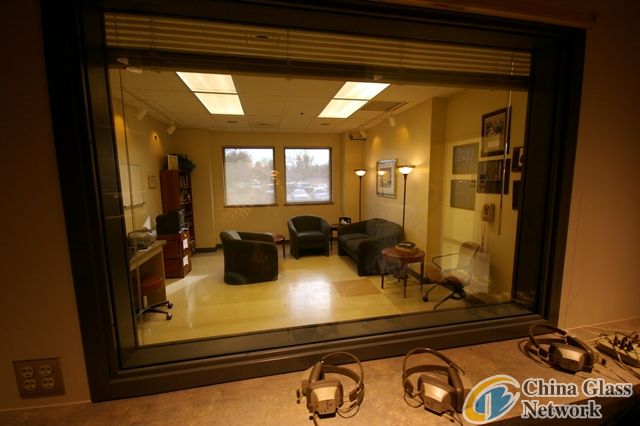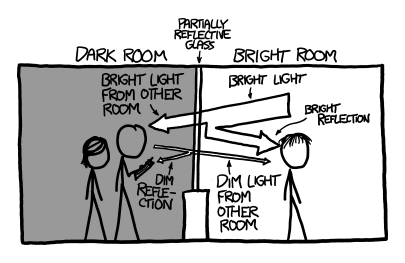Through the looking glass
 For generations, humans have been fascinated by the idea that they are being watched - and sometimes rightfully so. In more recent history, this belief has manifest itself as a suspicion that someone on the other side of the mirror is watching. Is a “two-way mirror” possible, is this a real issue, how can one detect such a device, and why do we worry about this so much?
For generations, humans have been fascinated by the idea that they are being watched - and sometimes rightfully so. In more recent history, this belief has manifest itself as a suspicion that someone on the other side of the mirror is watching. Is a “two-way mirror” possible, is this a real issue, how can one detect such a device, and why do we worry about this so much?
This technology is actually quite old - a patent for a “transparent mirror” was issued in 1903 (Wilson), but the process of creating such a device was prohibitively expensive. It was not until 1951 that Samuel Pinneau published a paper detailing a method for producing a “partial mirror” for a tenth of the previous cost. In a regular mirror, a sheet of glass is coated with a silver compound, causing light to reflect an image back at the viewer. Pinneau explains that “the term ‘one-way mirror’ is actually a misnomer for half-silvered or partial mirrors” (Pinneau 235) - meaning that the device will reflect half of the light that hits it, allowing the rest to pass through. This causes the appearance of a mirror on one side, and a window on the other. As light may pass through from either side, the observation room must be substantially darker than the other, or substantial amounts of light will pass through from both sides, causing the two-way mirror to function more like a dirty window than a mirror.
With an understanding of the operative mechanism of a two-way mirror, the question at hand now becomes whether the legend is true and a two-way mirror has ever been placed in a dressing room or bathroom. For evidence in the matter, we can turn to the first-hand video account of comedian Tamale Rocks in a bar bathroom. She describes how she entered the bathroom and observed that there was a full length mirror directly opposite the lady’s toilet. As the situation seemed atypical, she elected to investigate before relieving herself. Upon inspection, she discovered that the mirror was affixed to the front of a cleaning closet. She opened the door, which was unlocked, peeked inside, and discovered a two-way mirror. She decided that it was a big enough issue that she made a short video showing the scene and explaining how she discovered it (Rocks). It may be noted, however, that the supply closet had only one entrance, which was within the one person bathroom, and that the door was left unlocked so that patrons could investigate and make sure there was no one in the room. A similar story was reported of a nightclub in Glascow (Berman).
As some bathrooms have been shown to have two way mirrors, is there a set of simple, foolproof tests to determine if someone is sitting on the other side of that mirror? The first and simplest test, a sort of common sense test, is to consider the motivation of someone to look through the mirror in question - what could they see if it was a two way mirror? If there isn’t anything at least moderately interesting on this side of the mirror, chances are, nobody bothered to put in a two way mirror. If the positioning of the mirror seems suspicious, you can move on to more rigorous testing. The most widely known of these tests, something of an urban legend in its own right, is that you can test by touching your finger to the mirror. A regular mirror is typically silvered on the back of the the glass,
meaning that if you touched the mirror, there would be a gap between your finger and its reflection. If the reflection of your finger does touch, then the mirror has been silvered on the outside surface - indicating that it is probably a two-way mirror. While this test is good, it is not perfect. If you are really suspicious, you could always try hitting the mirror with a chair - but that could get really awkward if you are wrong. Better tests are observing the manner in which the mirror is mounted, knocking, or cupping your hands and attempting to look through. A regular mirror is often hung on a wall, while a two-way mirror is more likely to be set into a wall with a viewing room on the other side. Knocking on the window is probably the simplest test. If it’s hung on the wall - like a proper mirror - it won’t echo, but the open space on the other side of a two-way mirror will produce an easily recognizable sound. Blocking out light by cupping your hands, pressing them to the glass and looking through blocks the reflection and allows one to see any light, however minimal, coming from the other side (Mikkelson).
 Why does the legend persist? While there have been real cases of two-way mirrors being found in bathrooms or changing rooms, they are sufficiently infrequent that the average person will probably never encounter one. Socially, there are certain norms - certain things, like using the toilet, that you just don’t do with someone watching. It doesn’t matter how well you do or do not know someone, you just don’t watch them when they are taking care of that part of life - but there are some pretty weird people out there. This leads us to wonder, to the mirror or even an empty room, “who is watching me?”
Why does the legend persist? While there have been real cases of two-way mirrors being found in bathrooms or changing rooms, they are sufficiently infrequent that the average person will probably never encounter one. Socially, there are certain norms - certain things, like using the toilet, that you just don’t do with someone watching. It doesn’t matter how well you do or do not know someone, you just don’t watch them when they are taking care of that part of life - but there are some pretty weird people out there. This leads us to wonder, to the mirror or even an empty room, “who is watching me?”
Works Cited
Berman, Taylor. "Nightclub Investigated for Installing 2-Way Mirror in Women's Bathroom." Gawker. 21 May 2013. Web. 06 Feb. 2016.
Mikkelson, Barbara. "How to Detect a Two-way Mirror." Snopes. 27 Apr. 2015. Web. 31 Jan. 2016.
Pinneau, Samuel R. "A Technique for Making One-Way Mirrors." Child Development 22.3 (1951): 235-41. Ebscohost. Web. 30 Jan. 2016.
Rocks, Tamale. "Woman In The Mirror." YouTube. May 2015. Web. 30 Jan. 2016. Video log of author's experience encountering a two-way mirror in a women's bathroom.
Wilson, Richard. Transparent Mirror. Richard Wilson, assignee. Patent US728063A. 12 May 1903. Print.
Photo Credit:
Photo Credit:
Bonvicini, Monica. Two-mirror-public-bathroom-exhibit-383382.jpg. 2015. Master Bathroom Ideas. Web. 6 Feb. 2016. <http://wowbathroomideas.net/two-way-mirror-bathroom/way-like-monica-bonvicini-two-mirror-public-bathroom-exhibit-383382/>.
China Glass Network. Web. 6 Feb. 2016. <http://www.glassinchina.com/sell/sellDisplay_393617.html>.
Short_answers_oneway.png. 2012. What-if.xkcd. By Randall Munroe. Web. 6 Feb. 2016. <https://what-if.xkcd.com/14/>.
*Note: This post created for a writing assignment at Utah State University
